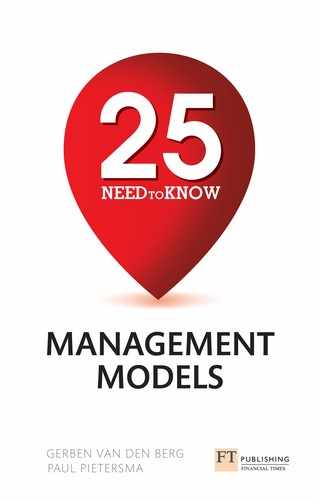Six sigma
- Why use it? Six sigma is used to improve the operational performance of an organisation by identifying and dealing with its deficiencies.
- What does it do? Six sigma claims that focusing on reduction of variation (beyond the sixth sigma) will solve process and business problems.
- When to use it? Six sigma projects can help achieve better financial results by improving quality and process reliability.
- What questions will it help you answer? Which financial improvements and cost savings can be achieved? What efficiencies can be gained by reducing variation in processes?
The big picture
The name six sigma originates from statistical terminology. Sigma is the mathematical symbol for standard deviation. Six sigma is a measure of the maximum number of defects that are allowed in a system. At the six sigma level, 99.999998 per cent of all products must be good, i.e. they fall within the tolerance limits (see Figure 15.1). This implies that no more than 3.4 defects are produced in one million opportunities. This level can be achieved by reducing the variation of the process and controlling it. To reach this quality level, the processes must be improved. However, process and quality improvements are not the ultimate goal – financial improvement is the goal.
Six sigma first became rooted at Motorola. To confront heavy Japanese competition, in 1987 Motorola started to focus on quality improvement. The engineers at Motorola decided that the norm they were using, of defects per 1000 units, was no longer appropriate. They therefore decided to measure the defects per million. Allied Signal and General Electric have perfected the method. These firms have realised huge benefits by saving billions of dollars whilst improving customer satisfaction. Nowadays, six sigma projects are implemented not only in manufacturing firms, but also in the service industry.

Figure 15.1 Six sigma
Source: after Van Assen, Notermans and Wigman (2007)
Six sigma claims that focusing on reduction of variation will solve process and business problems. By using a set of statistical tools to understand the fluctuation of a process, management can begin to predict the expected outcome of that process. If the outcome is not satisfactory, other statistical tools can be used to further understand the elements that influence the process.
When to use it
Six sigma is used to improve the operational performance of an organisation by identifying and dealing with its deficiencies. Six sigma projects help to achieve better financial results by improving quality and process reliability. Every six sigma project has to focus on financial improvements and cost savings. The six sigma philosophy suggests that top management should not authorise a project that does not have a savings target of at least $175,000.
Six sigma is a top-down method where management has to communicate the goal of each project and audit it. The organisation’s employees carry out the projects in a very structured way. The employees have one of the following roles:
- Executive management champions – the CEO or other key management team members that have a clear overview of the six sigma projects.
- Master black belts – external consultants who train the black belts and support six sigma projects.
- Black belts – the project leaders, who execute overall project
management. - Green belts – the project leaders of a part of a project, who implement six sigma projects.
- Project teams – each green belt has a project team. These employees are trained in the six sigma techniques.
The infrastructure of a six sigma project is unique for every organisation. Nevertheless, general requirements for successful implementation can be determined:
- A good understanding of statistical tools and techniques.
- Spending adequate resources on the definition phase.
- Spending adequate resources on the implementation phase.
- Effective management leadership and commitment.
- Undergoing a cultural change before implementation.
- Having an effective communication plan.
- Providing adequate training for the improvement teams.
- Having black belts with the ability to facilitate.
How to use it
Six sigma includes five steps: define, measure, analyse, improve and control (commonly known as DMAIC):
- Define. First of all, a selection of the processes that must be improved has to take place, and the goals for improvement should be defined (SMART – specific, measurable, acceptable, realistic and time-specific).
- Measure. After the definition phase, data are collected to evaluate the performance of the current process for future comparison.
- Analyse. The difference between the current state and the desired state is determined in this phase.
- Improve. Subsequently the process is optimised based on the analysis.
- Control. The new improved processes should be controlled and formalised.
The final analysis
Six sigma comprises hard and soft techniques. The harder ones include a structured problem-solving approach, statistical process control tools (applied using DMAIC methodology) and project management techniques. The softer ones include people management, creativity and improvement motivation.
Benchmarking (see Chapter 6) is used in six sigma projects. The important characteristics of the product, the client, the internal process and the manufacturing system are compared with the products and processes of competitors. This is useful for financially orientated management, because the comparison at process level makes it possible to use six sigma techniques.
In six sigma projects, it is important to have vision and enthusiasm, but a requirement for successful projects is a well-defined infrastructure for training, support and project coordination.
References
Breyfogle III, F.W. (2003) Implementing Six Sigma: Smarter Solutions using Statistical Methods. Hoboken, New Jersey: John Wiley & Sons.
Van Assen, M.F., Notermans, R. and Wigman, J. (2007) Operational Excellence New Style. The Hague: Academic Service [in Dutch: Operational Excellence nieuwe stijl].
